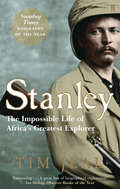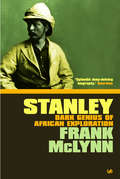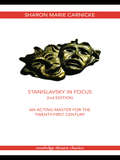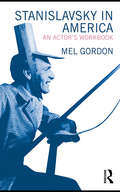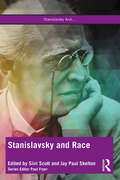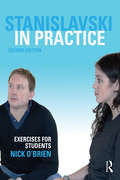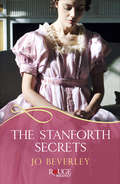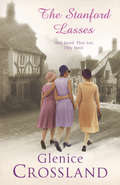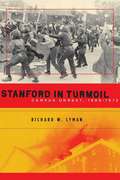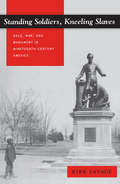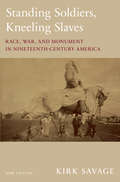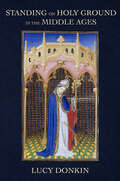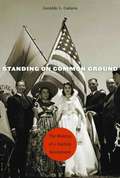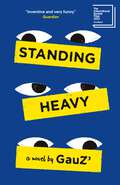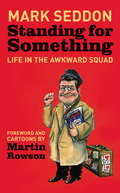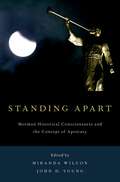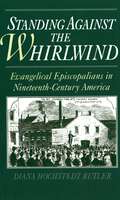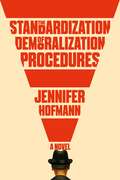- Table View
- List View
Stanley: Africa's Greatest Explorer
by Tim JealHenry Morton Stanley was a cruel imperialist - a bad man of Africa. Or so we think: but as Tim Jeal brilliantly shows, the reality of Stanley's life is yet more extraordinary. Few people know of his dazzling trans-Africa journey, a heart-breaking epic of human endurance which solved virtually every one of the continent's remaining geographical puzzles. With new documentary evidence, Jeal explores the very nature of exploration and reappraises a reputation, in a way that is both moving and truly majestic.
Stanley: The Making Of An African Explorer (Oxford Lives Ser.)
by Frank McLynnSir Henry Morton Stanley, greatest of African explorers, was one of the most fascinating late Victorian adventurers. Born into poverty and illegitimacy, he survived a series of incredible adventures at sea and in the USA to emerge as a journalist of talent after the American Civil War. His coverage of the British Ethiopian expedition to chastise Emperor Theodore brought him to the attention of James Gordon Bennett who commissioned him to find David Livingstone in Africa, the greatest single feat in African exploration. Yet behind the public man lay a disturbed personality. A pathological liar with sadomasochistic tendencies, Stanley's achievements exacted a high human cost. As Frank McLynn's masterly study shows, his foundation of the Congo Free State on behalf of Leopold II of Belgium, and the Emin Pasha Relief Expedition were both dubious enterprises which tarnished his reputation, revealing the complex - and often troubling - relationship that Stanley had with Africa.
Stanislavsky in Focus: An Acting Master for the Twenty-First Century
by Sharon Marie CarnickeFirst published in 1998. Routledge is an imprint of Taylor & Francis, an informa company.
Stanislavsky in Focus: An Acting Master for the Twenty-First Century
by Sharon Marie CarnickeFirst published in 1998. Routledge is an imprint of Taylor & Francis, an informa company.
Stanislavsky in America: An Actor's Workbook
by Mel GordonStanislavsky in America explores the extraordinary legacy that Constantin Stanislavski’s system of actor-training has left on acting in the US. Mel Gordon outlines the journey of Stanislavski’s theories through twentieth century American history, from the early US tours of the Moscow Art Theatre to the ongoing impact of 'The System' on modern American acting. This fascinating study by a leading theatre critic and practitioner provides hundreds of original acting exercises, used by the pivotal US figures who developed his teachings, such as Lee Strasberg, Stella Adler and Bobby Lewis. By going back to these primary sources, Gordon cuts through the myths and misapprehensions which have built up over time. Part memoir and part practical guide, Stanislavsky in America is an essential resource for anyone wanting to understand Stanislavski’s work and his relationship with American theatre.
Stanislavsky in America: An Actor's Workbook
by Mel GordonStanislavsky in America explores the extraordinary legacy that Constantin Stanislavski’s system of actor-training has left on acting in the US. Mel Gordon outlines the journey of Stanislavski’s theories through twentieth century American history, from the early US tours of the Moscow Art Theatre to the ongoing impact of 'The System' on modern American acting. This fascinating study by a leading theatre critic and practitioner provides hundreds of original acting exercises, used by the pivotal US figures who developed his teachings, such as Lee Strasberg, Stella Adler and Bobby Lewis. By going back to these primary sources, Gordon cuts through the myths and misapprehensions which have built up over time. Part memoir and part practical guide, Stanislavsky in America is an essential resource for anyone wanting to understand Stanislavski’s work and his relationship with American theatre.
Stanislavsky and Race: Questioning the “System” in the 21st Century (Stanislavsky And...)
by Siiri Scott Paul SkeltonStanislavsky and Race is the first book to explore the role that Konstantin Stanislavsky’s “system” and its legacies can play in building, troubling and illuminating today’s anti-racist theatre practices. This collection of essays from leading figures in the field of actor training stands not only as a resource for a new area of academic enquiry, but also for students, actors, directors, teachers and academics who are engaged in making inclusive contemporary theatre. In seeking to dismantle the dogma that surrounds much actor training and replace it with a culturally competent approach that will benefit our entire community, the “system” is approached from a range of perspectives featuring the research, reflections and provocations of 20 different international artists interrogating Stanislavsky’s approach through the lens of race, place and identity. Stanislavsky and … is a series of multi-perspectival collections that bring the enduring legacy of Stanislavskian actor training into the spotlight of contemporary performance culture, making them ideal for students, teachers and scholars of acting, actor training and directing.
Stanislavsky and Race: Questioning the “System” in the 21st Century (Stanislavsky And...)
Stanislavsky and Race is the first book to explore the role that Konstantin Stanislavsky’s “system” and its legacies can play in building, troubling and illuminating today’s anti-racist theatre practices. This collection of essays from leading figures in the field of actor training stands not only as a resource for a new area of academic enquiry, but also for students, actors, directors, teachers and academics who are engaged in making inclusive contemporary theatre. In seeking to dismantle the dogma that surrounds much actor training and replace it with a culturally competent approach that will benefit our entire community, the “system” is approached from a range of perspectives featuring the research, reflections and provocations of 20 different international artists interrogating Stanislavsky’s approach through the lens of race, place and identity. Stanislavsky and … is a series of multi-perspectival collections that bring the enduring legacy of Stanislavskian actor training into the spotlight of contemporary performance culture, making them ideal for students, teachers and scholars of acting, actor training and directing.
Stanislavski in Practice: Exercises for Students
by Nick O'BrienStanislavski in Practice is an unparalleled step-by-step guide to Stanislavski’s system. Author Nick O’Brien makes this cornerstone of acting accessible to teachers and students alike through the use of practical exercises that allow students to develop their skills. This second edition offers more exercises for the actor, and also new sections on directing and devising productions. Each element of the system is covered practically through studio exercises and jargon-free discussion. Exercises are designed to support syllabi from Edexcel, Eduqas, OCR and AQA to the practice-based requirements of BTEC and IB Theatre. This is the perfect exercise book for students and a lesson planner for teachers at post-16 and first year undergraduate level. New to this edition: Thoroughly reorganized sections, including 'Work on the Actor', 'Work on a Role' and 'Developing your Practice'; A new chapter on using Stanislavski when devising with a series of exercises that will allow students to structure and create characters within the devising process; A new chapter, Directing Exercise Programme, which will be a series of exercises that allows the student to develop their skills as a director; New glossary with US and UK terms; New exercises developed since the publication of the first edition; A new chapter going beyond Stanislavski, exploring exercises from Michael Chekhov, Maria Knebel and Katie Mitchell.
Stanislavski in Practice: Exercises for Students
by Nick O'BrienStanislavski in Practice is an unparalleled step-by-step guide to Stanislavski’s system. Author Nick O’Brien makes this cornerstone of acting accessible to teachers and students alike through the use of practical exercises that allow students to develop their skills. This second edition offers more exercises for the actor, and also new sections on directing and devising productions. Each element of the system is covered practically through studio exercises and jargon-free discussion. Exercises are designed to support syllabi from Edexcel, Eduqas, OCR and AQA to the practice-based requirements of BTEC and IB Theatre. This is the perfect exercise book for students and a lesson planner for teachers at post-16 and first year undergraduate level. New to this edition: Thoroughly reorganized sections, including 'Work on the Actor', 'Work on a Role' and 'Developing your Practice'; A new chapter on using Stanislavski when devising with a series of exercises that will allow students to structure and create characters within the devising process; A new chapter, Directing Exercise Programme, which will be a series of exercises that allows the student to develop their skills as a director; New glossary with US and UK terms; New exercises developed since the publication of the first edition; A new chapter going beyond Stanislavski, exploring exercises from Michael Chekhov, Maria Knebel and Katie Mitchell.
The Stanforth Secrets: A Rouge Regency Romance
by Jo BeverleyHe holds her freedom and her heart...It has fallen to Chloe, the widowed Lady Stanforth, to manage the affairs of Delamere Hall. And when her husband’s cousin arrives – a man for whom she has long harboured a deep and guilty attraction – she finds she may just want to stick around.Newly returned from the war, Justin Delamere hopes he can finally woo Chloe. But he is ordered to search Delamere Hall for missing documents – documents that might prove Chloe guilty of treason, and perhaps even of murder. Can he trust the woman he has always desired? And can Chloe surrender her most private secrets to the man who holds her fate in his hands?
The Stanford Lasses
by Glenice CrosslandThey loved. They lost. They lived.In the small Yorkshire town of Cottenly - dominated by the steel works and surrounded by beautiful countryside - Isaac Stanford lives with his wife Emily and their three lovely daughters, known locally as the Stanford lasses. Alice, the eldest, lives only for her work as a secretary and chapel on Sunday. Fair and loving Lizzie is content with her job making umbrellas - until she falls in love with George Crossman and all she desires is to be a wife and mother. And headstrong Ruth, the merry one, is intent upon marrying handsome charmer, Walter Wray, despite warnings from friends and family. Already emotionally damaged by a traumatic childhood, Alice struggles to lead a normal life. Poor but happy with her ever increasing family, with the onset of war, Lizzie faces the threat of losing all she holds dear. And Ruth soon realises she has made a terrible mistake in her marriage as she becomes trapped in a life of poverty and violence. As the years pass each sister is forced to confront her greatest challenge ...
Stanford in Turmoil: Campus Unrest, 1966-1972
by Richard W. LymanStanford in Turmoil is a rare insider's look at one school's experience of dramatic political unrest during the late 1960s and early 1970s. It provides a unique perspective on the events that roiled the campus during this period—a period in which the author, Richard Lyman, served as the university's vice president, provost, and then president. In a cross between memoir and history, the book guides us through major cases of arson, including the destruction of the president's office, the notorious "Cambodia Spring" of 1970—when dozens of students and police were injured—and the forced resignation of another Stanford president after just nineteen months in office. Remarkably, Stanford's prestige and academic strength grew unabated throughout this time of crisis. How this came to pass is the central theme of Stanford in Turmoil.
Standing Soldiers, Kneeling Slaves: Race, War, and Monument in Nineteenth-Century America
by Kirk SavageThe United States of America originated as a slave society, holding millions of Africans and their descendants in bondage, and remained so until a civil war took the lives of a half million soldiers, some once slaves themselves. Standing Soldiers, Kneeling Slaves explores how that history of slavery and its violent end was told in public space--specifically in the sculptural monuments that increasingly came to dominate streets, parks, and town squares in nineteenth-century America. Here Kirk Savage shows how the greatest era of monument building in American history arose amidst struggles over race, gender, and collective memory. As men and women North and South fought to define the war's legacy in monumental art, they reshaped the cultural landscape of American nationalism. At the same time that the Civil War challenged the nation to reexamine the meaning of freedom, Americans began to erect public monuments as never before. Savage studies this extraordinary moment in American history when a new interracial order seemed to be on the horizon, and when public sculptors tried to bring that new order into concrete form. Looking at monuments built and unbuilt, Savage shows how an old image of black slavery was perpetuated while a new image of the common white soldier was launched in public space. Faced with the challenge of Reconstruction, the nation ultimately recast itself in the mold of the ordinary white man. Standing Soldiers, Kneeling Slaves, the first sustained investigation of monument building as a process of national and racial definition, probes a host of fascinating questions: How was slavery to be explained without exploding the myth of a "united" people? How did notions of heroism become racialized? And more generally, who is represented in and by monumental space? How are particular visions of history constructed by public monuments? Written in an engaging fashion, this book will appeal to a wide range of readers interested in American culture, race relations, and public art.
Standing Soldiers, Kneeling Slaves: Race, War, and Monument in Nineteenth-Century America
by Kirk SavageThe United States of America originated as a slave society, holding millions of Africans and their descendants in bondage, and remained so until a civil war took the lives of a half million soldiers, some once slaves themselves. Standing Soldiers, Kneeling Slaves explores how that history of slavery and its violent end was told in public space--specifically in the sculptural monuments that increasingly came to dominate streets, parks, and town squares in nineteenth-century America. Here Kirk Savage shows how the greatest era of monument building in American history arose amidst struggles over race, gender, and collective memory. As men and women North and South fought to define the war's legacy in monumental art, they reshaped the cultural landscape of American nationalism. At the same time that the Civil War challenged the nation to reexamine the meaning of freedom, Americans began to erect public monuments as never before. Savage studies this extraordinary moment in American history when a new interracial order seemed to be on the horizon, and when public sculptors tried to bring that new order into concrete form. Looking at monuments built and unbuilt, Savage shows how an old image of black slavery was perpetuated while a new image of the common white soldier was launched in public space. Faced with the challenge of Reconstruction, the nation ultimately recast itself in the mold of the ordinary white man. Standing Soldiers, Kneeling Slaves, the first sustained investigation of monument building as a process of national and racial definition, probes a host of fascinating questions: How was slavery to be explained without exploding the myth of a "united" people? How did notions of heroism become racialized? And more generally, who is represented in and by monumental space? How are particular visions of history constructed by public monuments? Written in an engaging fashion, this book will appeal to a wide range of readers interested in American culture, race relations, and public art.
Standing Soldiers, Kneeling Slaves: Race, War, and Monument in Nineteenth-Century America, New Edition
by Kirk SavageThe United States began as a slave society, holding millions of Africans and their descendants in bondage, and remained so until a civil war took the lives of a half million soldiers, some once slaves themselves. Standing Soldiers, Kneeling Slaves explores how the history of slavery and its violent end was told in public spaces—specifically in the sculptural monuments that came to dominate streets, parks, and town squares in nineteenth-century America. Looking at monuments built and unbuilt, Kirk Savage shows how the greatest era of monument building in American history took place amid struggles over race, gender, and collective memory. Standing Soldiers, Kneeling Slaves probes a host of fascinating questions and remains the only sustained investigation of post-Civil War monument building as a process of national and racial definition. Featuring a new preface by the author that reflects on recent events surrounding the meaning of these monuments, and new photography and illustrations throughout, this new and expanded edition reveals how monuments exposed the myth of a "united" people, and have only become more controversial with the passage of time.
Standing Soldiers, Kneeling Slaves: Race, War, and Monument in Nineteenth-Century America, New Edition
by Kirk SavageThe United States began as a slave society, holding millions of Africans and their descendants in bondage, and remained so until a civil war took the lives of a half million soldiers, some once slaves themselves. Standing Soldiers, Kneeling Slaves explores how the history of slavery and its violent end was told in public spaces—specifically in the sculptural monuments that came to dominate streets, parks, and town squares in nineteenth-century America. Looking at monuments built and unbuilt, Kirk Savage shows how the greatest era of monument building in American history took place amid struggles over race, gender, and collective memory. Standing Soldiers, Kneeling Slaves probes a host of fascinating questions and remains the only sustained investigation of post-Civil War monument building as a process of national and racial definition. Featuring a new preface by the author that reflects on recent events surrounding the meaning of these monuments, and new photography and illustrations throughout, this new and expanded edition reveals how monuments exposed the myth of a "united" people, and have only become more controversial with the passage of time.
Standing on Holy Ground in the Middle Ages
by Lucy DonkinStanding on Holy Ground in the Middle Ages illuminates how the floor surface shaped the ways in which people in medieval western Europe and beyond experienced sacred spaces.The ground beneath our feet plays a crucial, yet often overlooked, role in our relationship with the environments we inhabit and the spaces with which we interact. By focusing on this surface as a point of encounter, Lucy Donkin positions it within a series of vertically stacked layers—the earth itself, permanent and temporary floor coverings, and the bodies of the living above ground and the dead beneath—providing new perspectives on how sacred space was defined and decorated, including the veneration of holy footprints, consecration ceremonies, and the demarcation of certain places for particular activities.Using a wide array of visual and textual sources, Standing on Holy Ground in the Middle Ages also details ways in which interaction with this surface shaped people's identities, whether as individuals, office holders, or members of religious communities. Gestures such as trampling and prostration, the repeated employment of specific locations, and burial beneath particular people or actions used the surface to express likeness and difference. From pilgrimage sites in the Holy Land to cathedrals, abbeys, and local parish churches across the Latin West, Donkin frames the ground as a shared surface, both a feature of diverse, distant places and subject to a variety of uses over time—while also offering a model for understanding spatial relationships in other periods, regions, and contexts.
Standing on Common Ground: The Making Of A Sunbelt Borderland
by Geraldo L. CadavaStanding on Common Ground locates the roots of today's debates over border enforcement in the Sunbelt's pan-ethnic and transnational history, as cross-border ties in the 1940s among entrepreneurs and politicians, and a flourishing cultural traffic among tourists and students, gave way to economic instability and illegal labor migration.
Standing on Common Ground: The Making Of A Sunbelt Borderland
by Geraldo L. CadavaStanding on Common Ground locates the roots of today's debates over border enforcement in the Sunbelt's pan-ethnic and transnational history, as cross-border ties in the 1940s among entrepreneurs and politicians, and a flourishing cultural traffic among tourists and students, gave way to economic instability and illegal labor migration.
Standing Heavy
by GauzInitially a little intrigued, all babies eventually return the security guard's smile.The security guard adores babies. Perhaps because babies do not shoplift.Babies adore the security guard. Perhaps because he does not drag babies to the sales.The 1960s - Ferdinand arrives in Paris from Côte d'Ivoire, ready to take on the world and become a big somebody.The 1990s - It is the Golden Age of immigration, and Ossiri and Kassoum navigate a Paris on the brink of momentous change.The 2010s - In a Sephora on the Champs-Élysées, the all-seeing eyes of a security guard observes the habits of those who come to worship at this church to consumerism.Amidst the political bickering of the inhabitants of the Residence for Students from Côte d'Ivoire and the ever-changing landscape of French immigration policy, Ferdinand, Ossiri and Kassoum, two generations of Ivoirians, attempt to make their way as undocumented workers, taking shifts as security at a flour mill.Sharply satirical, political and poignant, Standing Heavy is a searingly witty deconstruction of colonial legacies and capitalist consumption, an unprecedented and unforgettable account of everything that passes under a security guard's gaze.Translated from the French by Frank Wynne"A formidable keenness of observation and a sarcastic wit" La Croix "Political satire with the air of a poetry slam" Stylist
Standing for Something: Life in the Awkward Squad
by Mark SeddonMark Seddon is best known in Britain as a leading member of the Awkward Squad, a thorn in the flesh of New Labour as editor of Tribune, house magazine of the Left, for over a decade. In that role and as a member of Labour's National Executive Committee, he scurried around the corridors of power, gaining a unique perspective on the activities of Blair, Brown and Mandelson - and of less familiar figures who played their part in the story of New Labour. Standing for Something is the record of an unusual political life played out on an international stage.
Standing Apart: Mormon Historical Consciousness and the Concept of Apostasy
by Miranda Wilcox John D. YoungWinner of the Best Anthology Award from John Whitmer Historical Association Latter-day Saints have a paradoxical relationship to the past; even as they invest their own history with sacred meaning, celebrating the restoration of ancient truths and the fulfillment of biblical prophecies, they repudiate the eighteen centuries of Christianity that preceded the founding of their church as apostate distortions of the truth. Since the early days of Mormonism, Latter-day Saints have used the paradigm of apostasy and restoration in their narratives about the origin of their church. This has generated a powerful and enduring binary of categorization that has profoundly impacted Mormon self-perception and relations with others. Standing Apart explores how the idea of apostasy has functioned as a category to mark, define, and set apart "the other" in Mormon historical consciousness and in the construction of Mormon narrative identity. The volume's fifteen contributors trace the development of LDS narratives of apostasy within the context of both Mormon history and American Protestant historiography. They suggest ways in which these narratives might be reformulated to engage with the past, as well as offering new models for interfaith relations. This volume provides a novel approach for understanding and resolving some of the challenges faced by the LDS church in the twenty-first century.
Standing Against the Whirlwind: Evangelical Episcopalians in Nineteenth-Century America (Religion in America)
by Diana Hochstedt ButlerStanding Against the Whirlwind is a history of the Evangelical party in the Episcopal Church in nineteenth-century America. A surprising revisionist account of the church's first century, it reveals the extent to which evangelical Episcopalians helped to shape the piety, identity, theology, and mission of the church. Using the life and career of one of the party's greatest leaders, Charles Pettit McIlvaine, the second bishop of Ohio, Diana Butler blends institutional history with biography to explore the vicissitudes and tribulations of evangelicals in a church that often seemed inhospitable to their version of the Gospel. This gracefully written narrative history of a neglected movement sheds light on evangelical religion within a particular denomination and broadens the interpretation of nineteenth-century American evangelicalism as a whole. In addition, it elucidates such wider cultural and religious issues as the meaning of millennialism and the nature of the crisis over slavery.
The Standardization of Demoralization Procedures: a world of spycraft, betrayals and surprising fates
by Jennifer Hofmann'The best novel I've encountered this year, brilliant and funny and profound, producing some of the most complex, fascinating characters I've ever known. As far as I'm concerned, the novel is an instant classic' Jaroslav Kalfar, author of Spaceman of Bohemia'This is art of the highest order, a masterpiece of restraint, insight and style' Matthew Thomas, author of We Are Not Ourselves9th November 1989, East Berlin, the day the Berlin Wall will fall - Bernd Zeiger, a Stasi agent whose life's work, a manual on the demoralisation of political opponents, once made him renowned now faces an ailing psyche and the fading twilight of his career. His whole life has been reduced to a preoccupation with the disappearance of Lara, a young waitress at his local café. Twenty-five years earlier, during the Cold War, a physicist Johannes Held had been sent by the East Germans to infiltrate a US military operation in the Arizona desert, where teleportation and other paranormal activities were being investigated. On his return to Germany he refused to divulge what he had learned there and Zeiger was summoned to obtain his confession. The torturer and the tortured strangely became friends. But Zeiger soon betrayed Held - a treachery that haunts him to this day and one that will prove to be connected to Lara's disappearance. Darkly comic and hauntingly surreal, The Standardization of Demoralization Procedures examines obsession, Cold War paranoia and the dwindling career of a Stasi operative. Set against the brutal backdrop of communist East Germany, Hofmann's debut captures the fate of humanist fantasies under an extreme surveillance state.
